SUBCLINICAL ISOLATION OF EPSTEIN—BARR VIRUSES AND IMMUNITY IN WOMEN WITH GENITAL HERPES
DOI:
https://doi.org/10.21638/11701/spbu11.2017.408Abstract
The aim of the study was to study the incidence of asymptomatic determination of Epstein-Barr viruses (EBV) in women with genital herpes (GH) with a recurring course of the disease depending on the stage of the process of infection and the state of vaginal microbiota. It was shown that, in the case of a severe course of GH, this phenomenon is observed both with recurrence of the disease (28 % of cases) and remission (18 % of cases). This is facilitated by the immune response that forms in patients with Th2 type. With an average course of GH during remission, but against a background of bacterial vaginosis (BV), VEB is isolated in 23 % of cases, and after its treatment in 8 %. This is explained by the Th2 type of immune response, and the lack of local antiviral immunity in BV. It was shown that a decrease in the intensity of the local and general antiviral immune response is able to “include” the mechanism of asymptomatic VEB secretion. Refs 23. Figs 6. Tables 2.
Keywords:
Epstein—Barr viruses, genital herpes, bacterial vaginosis, general and local immunity
Downloads
References
References
virusom Epshteina—Barr [Pregnancy and infection caused by the virus Epstein-Barr]. Rossiiskii vestnik akushera-ginekologa [The Russian Bulletin of the obstetrician-gynecologist], 2014, no. 5, pp. 22–27. (In Russian)
virus reactivation in critically ill immunocompetent patients. Biomed. J., 2015, vol. 38, no. 1, pp. 70–76.
local inflammatory response and presence of cervical intraepithelial neoplasia in women with and without
human papilloma virus infection. Korean J. Obstet. Gynecol., 2012, vol. 55, no. 7, pp. 468–476.
Chandra N., Rabe L., Cunningham T. D., Anderson S. Bacterial vaginosis and subclinical markers of genital
tract inflammation and mucosal immunity. AIDS research and human retroviruses, 2015, vol. 31, no. 11,pp. 1139–1152.
International Journal of STD & AIDS, 2010, vol. 21, no. 3, pp. 191–194.
Downloads
Published
How to Cite
Issue
Section
License
Articles of "Vestnik of Saint Petersburg University. Medicine" are open access distributed under the terms of the License Agreement with Saint Petersburg State University, which permits to the authors unrestricted distribution and self-archiving free of charge.




